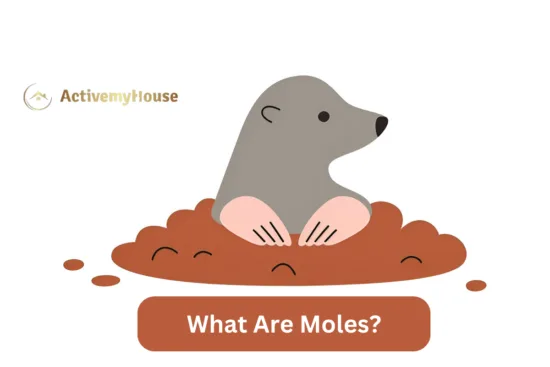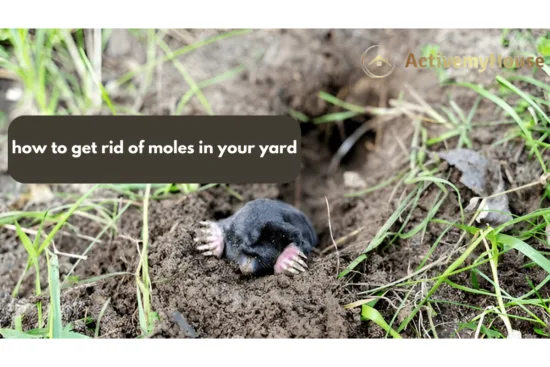Having trouble with moles messing up your lawn? You are not the only one. Learning how to get rid of moles begins with understanding their behavior—such as their love for grubs and loose soil—before you go the route of removal.
Natural repellents or traps; this guide has got it all when it comes to knowing how to get rid of moles in your yard. DIY fixers or professionals, you really can do it all mess-free in reclaiming your yard.
What Are Moles?

It has pale gray, velvety fur, round tiny eyes, and claws adapted for digging. They are not rodents and primarily feed on insects, earthworms, and grubs, regarding the soil of your lawn pretty much as an all-fancy buffet. They do aerate your yard, but their tunneling habits leave ugly ridges and unearth plants, changing yards from orderly to messy. Understanding the mole’s habits comes first in learning how to get rid of moles with effective methods for control.
Understanding moles: behavior and why they invade your yard?

Beneath the surface of your manicured lawn operates a highly specialized earthmover—the mole. These solitary insectivores possess unique biological adaptations that make them formidable diggers: oversized paddle-like forelimbs, reduced eyesight, and velvety fur that allows effortless backward movement in tunnels.
The mole’s amazing tunneling ability gives it the capacity to build complex underground networks at an astonishing rate of up to 15 feet per hour. This speed leads to the development of characteristic ridges on the surface, making homeowners all the more frustrated.
The invasion of moles into your yard is not a random event but rather a calculated response to favorable environmental conditions.
These subterranean engineers are drawn toward properties offering three requisite conditions comfortable for survival: moist, well-aerated soil that is easy to excavate; an abundance of food such as earthworms and beetle larvae; and a setting with minimal disturbance from predators or human activity. Well-kept lawns ironically will provide one of the best habitats, which is why the most diligent of gardeners often endure the worst infestations.
Having insight into this ecological relationship is important because it allows for the design of effective, science-supported control options rather than renovate-the-situation-for-now options.
How to get rid of moles in your yard?

Moles are little diggers of nature; when their tunneling network in your lawn becomes too much, it is time to do something about it. The approach to get rid of moles should be pretty smart—either natural repellents, traps, or using long-term prevention methods. The most vital thing is knowing what works (or not) so that you can reclaim your yard minus the ecosystem damage.
Effective ways: how to get rid of moles?
From quick fixes to lasting solutions, here are the most reliable methods:
| Methods | How does it work? | Best for | Effectiveness |
| Castor Oil Spray | Makes soil taste/smell unappealing | Eco-friendly prevention | Moderate |
| Vibrating Stakes | Mimics predator vibrations, scaring moles | Low-effort deterrent | Mild to Moderate |
| Grub Control | Eliminates mole food source | Long-term prevention | High |
| Traps (Scissor/Harpoon) | Physically removes moles | Fast results | Very high |
Natural Solutions: If you’re against anything harsh, consider mixing castor oil with water (2:1 ratio) and spraying it along the tunnel. Moles do not like the taste and can evacuate. Flooding the tunnels with a garden hose works to encourage them to leave—but it is best used with small infestations.
For persistent problems, trapping is the best method to eliminate moles permanently. Scissor traps or harpoon traps set in active tunnels eliminate the problem humanely. Just remember to check local regulations.
Prevention Is Key: If grubs are indeed a mole’s favorite food, applying beneficial nematodes or milky spore powder to your lawn decreases their food supply. Keeping the soil drier (do not overwater) makes your yard an unfriendly habitat.
| Final Tip: If DIY efforts fail, it is worth bringing in the wildlife control expert to ensure the safe and effective removal of moles. |
Final words
Now that you know how to get rid of moles, you can take back your yard with confidence. Use either natural repellents or targeted traps or prevent it for the long haul; the remedy always begins from understanding how they behave. With the right approach, those annoying tunnels will be a thing of the past, and your lawn can recover as well. Bid farewell to mole havoc and welcome a smooth green grass carpet.
FAQs
What is the fastest way to get rid of moles?
The quickest method is using scissors or harpoon traps placed in active tunnels. For immediate (but temporary) results, flooding tunnels with a hose may drive them out.
What do moles hate most?
Moles hate castor oil-based repellents, vibrating stakes (which mimic predators), and dry, compact soil (which makes digging harder).
Does vinegar kill moles?
No, vinegar doesn’t kill moles—but soaking tunnels with a vinegar-water mix may irritate them enough to leave. For elimination, traps or grub control work better.
Will moles spoil my lawn foundation?
Yes. With time, the burrows have the capability to erode soil, disturb the roots, and create uneven ground, which is harmful to both turf and garden beds.
What time of day are moles most active?
Moles are active both day and night but usually dig surface tunnels early morning or evening during spring and fall.
Effective Blogs on Activemyhouse
2 bedroom super sleeper truck interior
Can tempered glass be cut
Average Height of House

